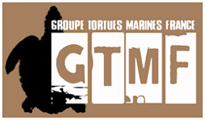Poster présenté au Symposium ISTS 29/2 au 4/3/2016 – Lima, Pérou
Sea turtles exposure to marine debris in French waters
G. Darmon1, C. Miaud1, D. Gambaiani2, F. Dell’Amico3, M. Authier4 , S. Catteau5, O. Brunel6, J. Befort7, F. Claro8, F. Galgani9
1 CEFE ; 2 CESTMed ; 3 Aquarium La Rochelle CESTM ; 4 Observatoire PELAGIS ; 5 Fondation Marineland ; 6 Fondation Albert 1er Prince de Monaco ; 7 Laboratoire départemental d’analyse du Gard ; 8 MNHN/ SPN / GTMF ; 9 IFREMER
Anthropogenic debris, mostly composed of plastics from land sources, is ubiquitous and a growing concern for marine ecosystems. Light and persistent, it passively drifts with the currents, posing a threat to the marine wildlife using the upper water column. More than 660 species are known to be affected by debris and all sea turtle species are impacted through entanglement, ingestion or pollution of their feeding and breeding habitats, directly or indirectly decreasing their chance of survival and reproduction.
The European Marine Strategy Framework Directive (MSFD) aims to achieve the good environmental status (GES) of the marine environment, defined for Descriptor 10 (D10), as the level of debris which does not cause harm to the coastal and marine environment. Given the extent of population distribution and the dispersion of individuals, the loggerhead turtle Caretta caretta was proposed as an indicator of ingestion (indicator 10.2.1) for D10, in order to assess debris level and impact in coastal and marine habitats. To better guide sea turtle conservation policies and evaluate the terms of use of the indicator, a better understanding of the risks posed to turtles by exposure to marine debris is crucial.
In this study, we evaluated the extent exposure of sea turtles to marine debris in the Atlantic and Mediterranean French and adjacent waters. Firstly, in order to assess ingestion rates and the quantities of debris ingested by loggerhead turtles, we analyzed debris found in the digestive contents of autopsied individuals by the French Atlantic and Mediterranean stranding networks and in the feces excreted by live individuals observed in the French Atlantic (CESTM -Aquarium La Rochelle) and Mediterranean (CESTMed) rehabilitation centers, before and after the establishment of the standard protocols suggested by the MSFD. Secondly, we analyzed the location data collected during aerial surveys of the marine megafauna carried out in winter 2011 and summer 2012 in the French Exclusive Economic Zone, in order to assess the risk of exposure of sea turtles to marine debris at sea.
This study confirms the propensity of loggerhead turtles to ingest debris and shows the significant probability of encountering marine debris at sea during their displacement, particularly in the Mediterranean. This highlights that marine debris represents a major threat to be considered in sea turtle conservation programs. In-depth studies, requiring empirical data on debris ingestion and simultaneous censuses of debris and turtles’ spatial distributions, are crucial.

